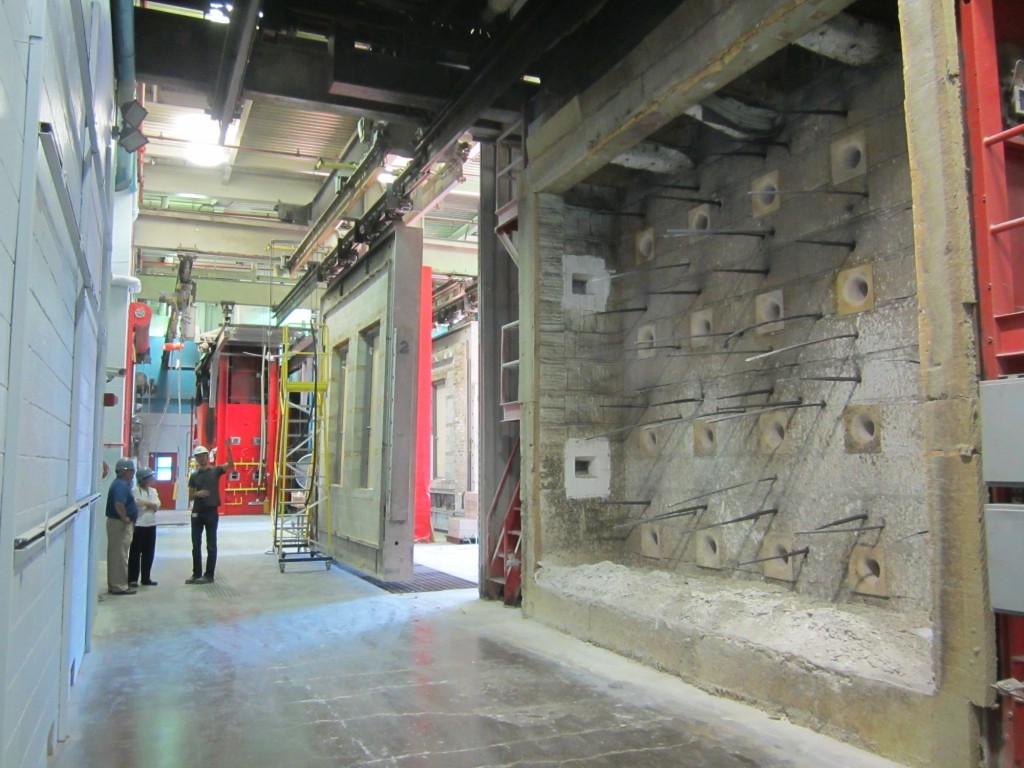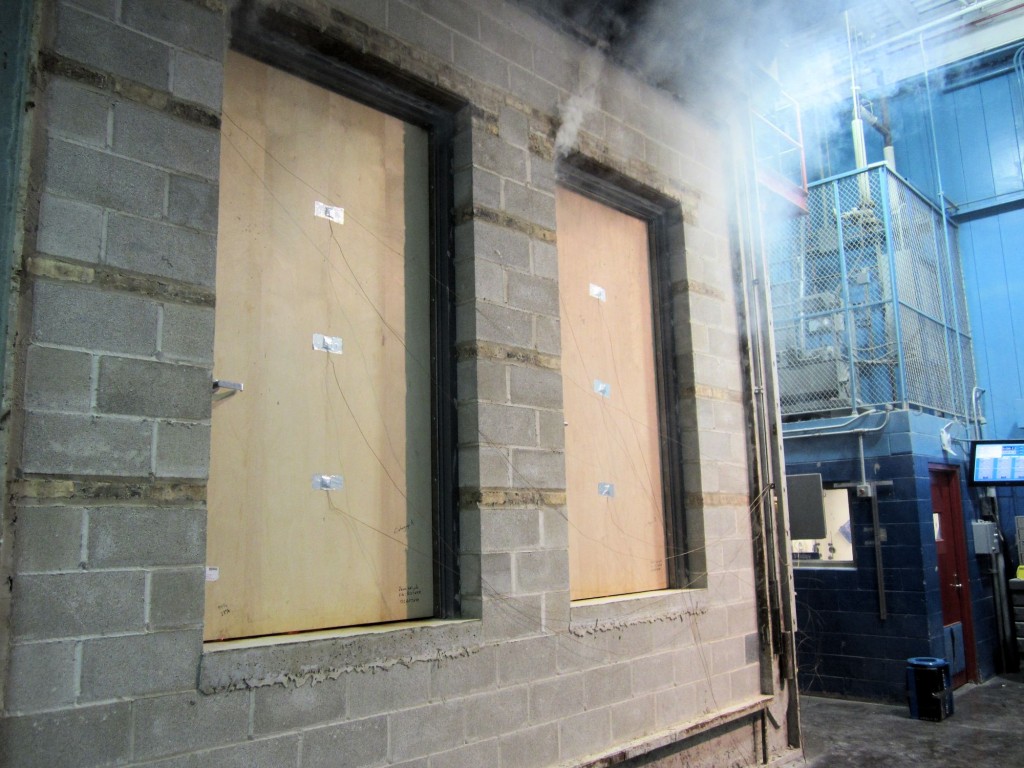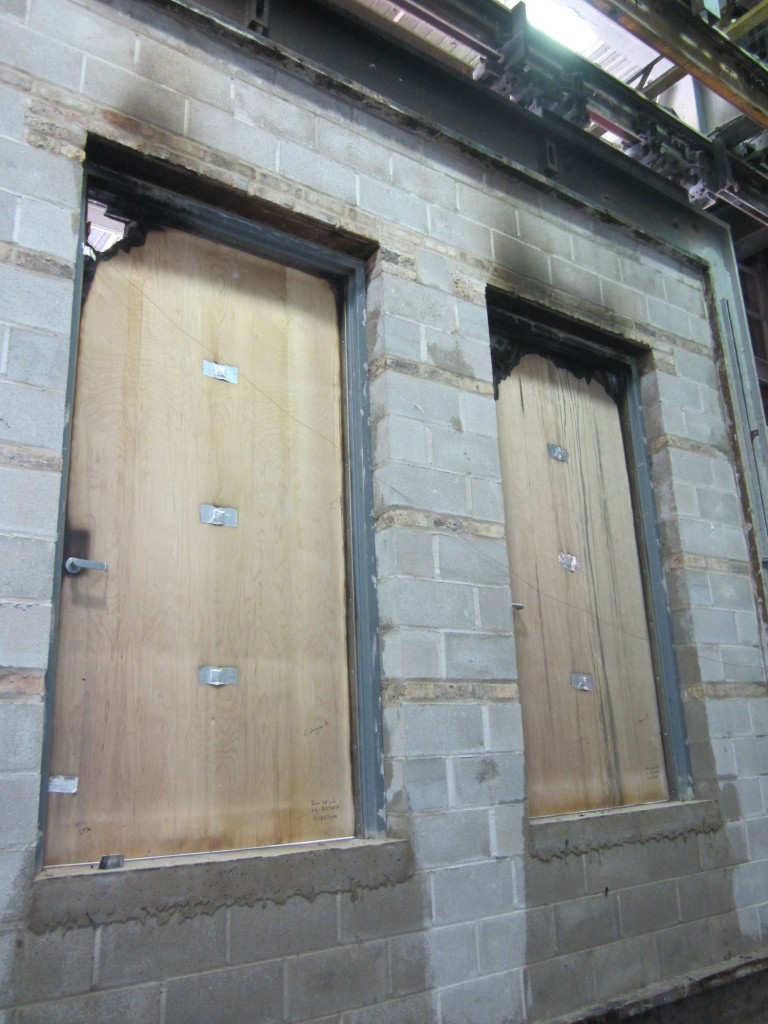I’m in Chicago today, to attend a fire test at Underwriters Laboratories in Northbrook. The product being tested is not an Allegion product – I was invited by Chuck and Courtney Noble of Certified Fire Door to witness testing on the Crown Fire Door Stop. This product is designed to be used on fire door assemblies where the clearances are larger than those allowed by NFPA 80 – 1/8″ maximum at the head, jambs, and meeting stiles for wood doors, 3/16″ maximum for hollow metal doors.
This is the second test for this product – the first test on wood doors did not pass (see photos below), although the product did achieve the UL listing for hollow metal doors. I attended the first test, and it was very disappointing when the wood doors failed. But in addition to the product redesign motivated by that test, there was a positive effect of the failure. The first test clearly demonstrated that a fire door with oversized clearances will not perform as designed if there is a real fire. Clearance problems are the most common issue found during a fire door inspection, and given the difficulty and expense of replacing doors to rectify a small clearance problem, it’s easy for some to justify leaving the doors as-is. But the doors failed in ideal circumstances (the test lab), and similar results would surely be seen under actual fire conditions.
I will tell you more about today’s test and the product sometime next week. We’re very excited to have several guests to witness the test, including a few people from Allegion’s local office, and two representatives from the International Fire Service Training Association (IFSTA) who will be photographing the test for some of their upcoming manuals. I will also be using video and photos from the test to make a short educational video about how fire doors are tested. Fingers crossed, everyone!
Meanwhile, my thoughts are with the Boston firefighters lost in yesterday’s Beacon Street fire. It is unknown whether fire doors played a part in that fire, although fire walls between the buildings did prevent the fire from spreading. What I take away from this fire and others, is that we need to be vigilant. It’s easier to prop open a door or block an egress route if you think “it will never happen to me…there will never be a fire in this building.” Many seem to think sprinklers solve all of the problems and there is no need for compartmentalization. While sprinklers are extremely valuable, we still need code-compliant fire doors to limit the smoke and flames, and free egress to help occupants escape.
Last night we ate dinner in a restaurant that had set up a server station in their rear exit, and installed a canvas entrance enclosure that had doors without panic hardware and closers that did not meet accessibility requirements. After dinner I checked into my hotel, and when the person checking me in was showing me the location of my room, he showed me a floor plan with two exits crossed out with Sharpie. He said, “these two exits are blocked off because we are renovating” – those were the only 2 exits on one side of the building (the side my room is on!). The fire doors in those exit enclosures are blocked open with wood wedges, and the doors have signage stating, “excuse our appearance…” with no instructions about where to find the nearest working exit. Luckily I’m on the second floor and there’s a sturdy pine tree next to my balcony, so I have a Plan B. Emails have already been sent about both situations.
It can happen here. It can happen to you, your loved ones, or strangers. The general public does not know about fire doors and egress doors. Don’t just pick up the wood wedge, educate the facility personnel about why it shouldn’t be there. Can you live with the potential effects of seeing a problem and doing nothing?
Here are some photos from the first test:
You need to login or register to bookmark/favorite this content.












You make excellent points! I need to pay closer attention to door clearance tolerances in my inspections.
I love hearing you say that! Say it again! 😉
No can do! Only one kudo per article! I’m pretty sure that’s a written code somewhere.
Seriously though, what did the clearance on those doors start at? 1/4″???
Well…ok. 🙂 The clearance was variable – similar to what you’d find in the field. I’ll ask Chuck what the clearance was for today’s test.
Fantastic article all the way through.
Can’t wait for the videos. Have seen a little fire testing, but it has been many years ago.
I guess you register under various names when you travel, to avoid the being turned down from being on the black list.
Well, there are some places I don’t dare go back to.
Wow! These pictures say a thousand words. I agree with you, most people too easily dismiss a slightly larger gap than allowed. The inspection criteria is what is it is. It is not a “kinda, sorta, close enough” thing. Follow the inspection points to the letter. In the end, if the AHJ wants to decide differently, then he/she has that power. As a fire door inspector, you don’t!
I need to remember to put “request room with sturdy tree adjacent to balcony” on my reservation requests ..
Thanks for sharing this
The funny thing is…one of my door hardware pals guessed which restaurant AND which hotel I was in. He saw the same problems there a few weeks ago!
Great article Lori, thank you for sharing. I really like watching the fire testing videos and you are right, it’s disappointing when a door starts to fail. It’s fascinating to see how the fire works on the doors and hardware and where the weak points are. I’ve never gotten to see one live and in person but I hope to one day. In the meantime, I’m looking forward to your videos!
Fascinating! Hoping to witness a fire test myself some day. Did the doors in your photos have resilient gasketing and intumescent seals, and yet they still failed? I’ve always wondered if “extra” stick-on stuff would help, sounds like Crown Fire Stop’s product will be a much better solution once the design and performance challenges are worked out. Thanks for posting!
The doors had a steel channel to extend the height of the stop, and a bulb smokeseal with intumescent.
Welcome to Chitown Lori
Thanks! I’m at O’Hare waiting to fly home. It was a quick one!